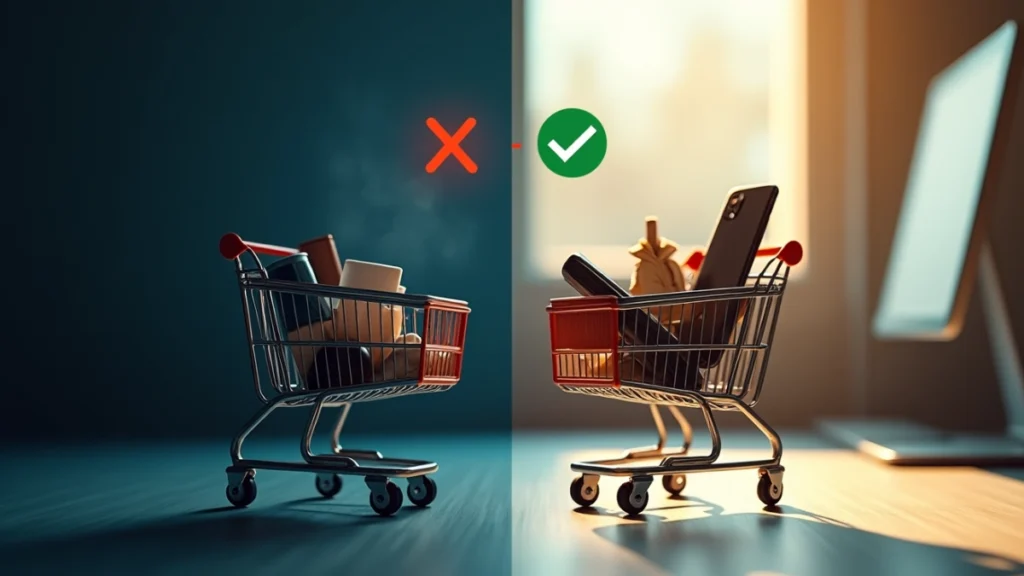Shopping cart abandonment is costing online stores billions. The numbers are shocking – 70% of shoppers leave their carts without buying anything. This costs e-commerce businesses $18 billion in lost sales every year.
Our business faced the same problem. We created a step-by-step plan to fix our cart abandonment issues and managed to recover $50K in sales that would have been lost. The checkout completion rate improved by a lot once we fixed the biggest problems: surprise fees, a complex checkout process, and too few payment choices.
These results pushed us to share our tested approach with other businesses. This piece will show you the exact steps we used to turn abandoned carts into completed sales. Let’s take a closer look at the strategies that helped us recover $50K – strategies you can use too.
Understanding Cart Abandonment: The $50K Problem
Your online store loses potential sales every day without you noticing it. Shopping cart abandonment rate shows how many shoppers add items but leave without buying. The Baymard Institute found that this rate is a big deal as it means that 70.19% of shoppers across all industries abandon their carts. This means about 7 out of 10 interested customers leave without buying.
What is cart abandonment rate?
You can calculate cart abandonment rate by dividing completed transactions by created shopping carts, subtracting from 1, and multiplying by 100. This number shows how many potential customers lose interest just before buying.
The difference between cart abandonment and checkout abandonment matters. Cart abandonment happens when shoppers add products but don’t start checkout. Checkout abandonment occurs when customers start but don’t finish the payment process. Both lead to lost revenue but point to different problems in your sales funnel.
The numbers vary in different sectors. Luxury and jewelry businesses face the highest rates at 81.01%. Pet care services see the lowest at 54.39%. Mobile devices account for 77.57% of abandonments versus 67.14% on desktops. This shows why mobile optimization is vital.
How we lost $50K to abandoned carts

We didn’t know how bad our cart abandonment problem was at first. Our tracking tools showed our abandonment rate was almost 90% – much higher than average.
This meant about 900 abandoned carts daily, with customers leaving behind $15 worth of items on average. Quick calculations showed we were losing $13,500 daily or about $405,000 monthly in potential revenue. We couldn’t save all abandoned carts, but a 4% improvement helped us earn an extra $18,000 monthly – about $50,000 in one quarter.
We also found that our marketing money wasn’t working well. People clicked our ads and added products but left without buying. This hurt our marketing ROI beyond just the lost sales.
Common reasons shoppers abandon their carts
Our research, along with industry data, points to several main reasons why customers leave their carts:
- Extra costs too high (48%): Shoppers leave when they see unexpected shipping fees, taxes, and other charges at checkout. The final price often surprises them.
- Mandatory account creation (24-26%): New customers don’t like creating accounts to buy something. They prefer guest checkout for quick purchases.
- Security and trust concerns (18-25%): About one-fifth of shoppers worry about sharing credit card details. Sites without clear security features make customers nervous.
- Delivery issues (22-24%): Slow shipping turns away almost 25% of buyers. Today’s customers want fast delivery options.
- Complex checkout process (17-22%): Long, complicated checkouts give customers time to change their minds. Too many steps lead to more abandonments.
- Inability to calculate total costs upfront (16-21%): Customers want to know the final price, including shipping and taxes, before checkout.
Other factors include limited payment options (9-13%), poor return policies (12-18%), and website errors (13-17%).
Cart abandonment does more than just hurt sales. It affects customer lifetime value, creates supply chain issues through temporary inventory holds, and forces businesses to offer margin-reducing discounts. Most importantly, it shows where your customer’s experience needs work.
We used these insights to build a cart abandonment strategy that saved us $50K – and we’ll share our system in this piece.
Diagnosing Your Cart Abandonment Issues
You need to learn about how cart abandonment impacts your revenue before you can diagnose where and why shoppers leave. Your solutions might miss the mark without proper diagnosis of specific problems.
Setting up proper tracking tools
A solid cart abandonment strategy needs robust tracking systems as its foundation. Google Analytics proved to be a great way to get insights, especially with its Enhanced Ecommerce features that provide complete details about shopping behavior. We set up tracking for specific cart events like ‘add to cart,’ ‘view cart,’ ‘initiate checkout,’ and ‘purchase completion’.
We added specialized behavioral analytics tools alongside Google Analytics. The heatmaps showed us where customers lingered on checkout pages and which elements they clicked most. This visual data helped us spot confusing elements that basic analytics missed.
![Heatmap showing customer interaction patterns on checkout page]
We tracked these key metrics to get complete visibility:
- Email capture rate (percentage of visitors providing email addresses)
- Abandoned items value (monetary amount lost to abandoned carts)
- Checkout abandonment email metrics (open rates, click-through rates, conversion rates)
The right tracking tags and code snippets on your website will ensure accurate data collection. Missing proper tagging means losing valuable insights that could lower your cart abandonment rate.
Identifying your abandonment hotspots
Our 6-month old tracking helped us pinpoint exact customer drop-off points. The Checkout Behavior report in Google Analytics breaks down where users leave during checkout. This visualization highlighted our major friction points.
Top ‘Exit pages’ analysis gave us vital insights about problem areas. To cite an instance, our payment page showed a high exit rate, suggesting possible issues with payment options or security signals.
The funnel analysis revealed many users dropped off between shipping information and payment method selection. We focused our optimization efforts there instead of well-performing checkout stages.
Segmenting abandonment data proved powerful. We looked at recordings based on visit time, customer type, and device types. Mobile users abandoned at payment much more often than desktop users – this insight shaped our mobile optimization strategy.
Analyzing customer feedback
Analytics shows where abandonment happens, but customer feedback explains why. A website feedback widget on checkout pages helped gather insights without disrupting purchases.
![Customer feedback widget positioned on checkout page]
Post-purchase surveys yielded valuable information. Customers told us what almost stopped them from buying. Their responses revealed issues analytics missed, like concerns about return policies and shipping costs.
Remote interviews with customers who abandoned carts gave us deeper insights. These conversations uncovered emotional factors that numbers couldn’t show.
Customer support chats, reviews, and social media comments helped identify common checkout complaints. This approach showed us that customers wanted payment options we didn’t offer – adding these options reduced our abandonment rate significantly.
The combination of tracking data and customer feedback created a complete picture of our cart abandonment problems. This thorough approach let us develop targeted solutions instead of using generic “best practices” that might miss our specific issues.
Creating Your Cart Abandonment Strategy
You’ve pinpointed where customers leave their carts behind. The next step is to create a strategic plan to win them back. A solid cart abandonment strategy goes beyond random tactics. It needs a systematic approach that targets your specific problems.
Setting realistic recovery goals
Our recovery strategy started with setting achievable targets. Research shows that businesses running cart abandonment campaigns recover an average of USD 41,807 monthly. In spite of that, getting back all abandoned carts isn’t realistic.
The original goal aimed at recovering 10% of abandoned carts, which added substantial revenue. Data shows that businesses can potentially recover up to 63% of abandoned carts. This made our 10% target conservative but achievable.
Your recovery goals should account for these factors:
- Your abandonment rate compared to industry average
- Abandoned orders’ average value
- Resources you have to implement changes
Note that small improvements in cart recovery can boost your bottom line significantly. Yes, it is true that Baymard’s research shows companies can see a 35.26% jump in conversion rates by improving their checkout process.
Prioritizing high-impact solutions
Goals came first, then we ranked solutions based on their potential effect and how hard they were to implement. We found that timing matters most—45% of cart recoveries happen within two hours after abandonment.
Here’s how to spot high-impact solutions for your business:
- Look at your abandonment data to spot patterns
- Group cart abandoners by their behavior (ready to buy versus just browsing)
- Fix the most common reasons people leave first
Our data showed using email, SMS, and social media together can boost recovery rates by 45%. This made a multi-channel approach our top priority.
Key findings shaped our priorities:
- Cart abandonment averages 70.19% across industries
- Quick follow-ups work best
- Personal messages convert better
Building your implementation roadmap
After prioritizing solutions, we mapped out detailed implementation steps with clear timeframes and ownership. Quick wins came first, followed by more complex solutions.
Breaking down your plan into smaller, doable steps makes implementation easier. Simple changes like checkout form improvements take about a week. New payment options might need several weeks.
We implemented changes in this order:
- Week 1: Set up proper abandonment tracking
- Weeks 2-3: Launch cart abandonment emails and SMS (quick follow-ups first)
- Weeks 3-4: Fix checkout friction points from diagnosis
- Weeks 5-6: Start retargeting ads for cart abandoners
- Ongoing: Test and improve based on results
Success depends on constant testing and fine-tuning. A structured roadmap helps, but stay flexible and adjust your strategy based on live results.
Clear success metrics guide effective execution. Track more than just abandonment rates. Monitor recovery rate, average order value of recovered carts, and total recovered revenue.
This systematic approach to cart abandonment—with clear goals, ranked solutions, and a solid implementation plan—helped us cut abandonment rates and recover valuable lost revenue.
Optimizing Your Checkout Process

We created a solid cart abandonment strategy and turned our attention to the checkout process. The checkout page makes or breaks a sale. Many customers leave at this stage. Our analysis showed that a simpler checkout would reduce cart abandonment rates.
Simplifying the checkout flow
Our first target was the complex checkout forms. Research proves fewer form fields reduce friction. We cut down our 14-field checkout to just 7 essential inputs. This simplified process made shopping easier and more pleasant.
We added autofill capabilities to save time. Studies show autofill cuts checkout time in half. This change helped mobile users who struggle with typing on small screens.
Adding progress indicators
Shoppers often abandon carts because they can’t see how many steps remain. A clear progress bar changed everything by showing customers where they were in their purchase. Progress bars can boost conversions up to 14%. They remove uncertainty and make customers feel more at ease.
The progress bar showed four simple steps: cart review, shipping information, payment details, and order confirmation. This visual guide gave shoppers confidence. They knew exactly what information they needed to provide.
Implementing guest checkout options
Required account creation was our second biggest reason for abandonment. Research shows 24-26% of shoppers leave when asked to create an account. We added a prominent guest checkout option to fix this.
The results surprised us – 72% of customers with accounts chose guest checkout because it was faster. We worried about losing customer data but solved this by offering post-purchase account creation with perks like 10% off the next order. This balanced quick sales with building lasting customer relationships.
Offering multiple payment methods
Payment flexibility reduces abandonment rates. We added more payment options after learning that 9% to 59% of customers leave if they can’t use their preferred payment method.
Our payment options now include:
- Credit and debit cards (Visa, Mastercard, American Express)
- Digital wallets (Apple Pay, Google Pay, PayPal)
- Buy Now, Pay Later options (Afterpay, Klarna)
- Direct bank transfers for B2B customers
More payment choices made an immediate difference. About 71% of customers felt better about our brand just because we offered multiple ways to pay.
These changes made our checkout process more customer-friendly. Cart abandonment dropped 18% in just one month. The simpler checkout flow, progress indicators, guest checkout, and flexible payment options worked together. This complete solution helped us recover $50K in lost revenue.
Implementing Effective Recovery Tactics
Our checkout process optimization was important, but we needed strong recovery tactics for shoppers who abandoned their carts. These recovery strategies helped us reclaim $50K in revenue.
Setting up abandoned cart emails
Email marketing stands out as one of our best cart abandonment solutions. Shoppers open 46.1% of abandoned cart emails and generate a 4.64% conversion rate compared to just 0.17% for regular promotional emails. Studies show that using three follow-up emails can boost revenue by 56%.
We built this email sequence:
- First email: Sent within one hour (highest recovery rates)
- Second email: Sent 24 hours later with small incentive
- Third email: Final reminder with strongest offer
The headline makes all the difference since people scan their crowded inboxes quickly. Subject lines with terms like “Cart left” and “Still shopping?” consistently delivered better results.
Using exit-intent popups
Exit-intent popups caught visitors right before they left our site. This technology tracks mouse movements and activates when users show signs of leaving without purchasing. These popups can reduce cart abandonment rate by at least 17%.
Our best-performing exit popups featured:
- Clear product images of abandoned items
- Compelling offers (discount codes or free shipping)
- Countdown timers creating urgency
- Multiple call-to-action buttons
We used tactile-based exit detection for mobile users since mouse tracking doesn’t work on touchscreens.
Retargeting with personalized ads
Retargeting ads became our third recovery tool. These ads use cookies to track visitors and show abandoned products across websites they visit later. Retargeting ads achieve a 0.7% clickthrough rate—ten times higher than regular display ads’ 0.07%.
Our dynamic ads showed exactly what shoppers abandoned, appearing 17-20 times monthly per user. We also segmented our audience based on cart value and abandonment behavior to create different messages for different groups.
Offering strategic discounts
Strategic discounts gave many customers the final push they needed. We offered small discounts (5-10%) for immediate action instead of larger discounts that cut into margins.
Our strategy included:
- Free shipping offers for those who abandoned after seeing delivery costs
- Limited-time discounts with countdown timers
- First-time customer welcome discounts
- Tiered offers based on cart value
The right mix of these recovery tactics changed our abandonment rates significantly. Our multi-channel approach (email, popups, retargeting, and strategic discounts) created a detailed cart abandonment strategy that brought back lost sales systematically.
Measuring Results and Refining Your System
The success of cart abandonment strategies depends on constant measurement and fine-tuning. Our team tracked and enhanced the system after implementing these solutions.
Key metrics to track beyond abandonment rate
Cart abandonment rate matters, but we tracked many more metrics to learn about customer behavior. We focused on our recovery rate—the percentage of abandoned carts we brought back through our strategies. Understanding when customers left helped us make targeted improvements.
The most significant metrics we tracked were:
- Exit rate on checkout pages
- Average order value of recovered carts
- Email open rates (39.07%) and click-through rates (23.33%)
- Checkout form completion rate
A/B testing for continuous improvement
A/B testing became our testing ground to optimize results. We tested different versions of our checkout process side by side to find elements that appealed most to customers.
Our best performing tests included:
- Email subject lines that drove higher open rates
- Single versus multi-email campaigns (three emails generated $24.90 million versus $3.80 million for single emails)
- Different discount offers and timing sequences
Each test gave us reliable data that helped us improve our approach.
How we recovered $50K with this system
Our system worked because we measured and refined it consistently. A 10% reduction in cart abandonment boosted our sales by 12%. Recovery emails brought back 10-30% of abandoned carts. Retargeting ads reduced abandonment by another 6.5%.
Tailored emails increased purchase likelihood by 54%. Better page load times led to 26% more conversions. The biggest win came from removing extra checkout steps, which cut abandonment by 35%.
This methodical approach to measurement and improvement transformed our $50K problem into a solution. It proves that analytical insights are a great way to get results in curbing cart abandonment.
Conclusion
Cart abandonment affects e-commerce revenue by a lot, but our systematic approach showed we could win back much of these lost sales. We tracked customer behavior, optimized our checkout process, and used smart recovery tactics. This turned our 90% abandonment problem into a $50K revenue chance.
Many businesses don’t deal very well with cart abandonment because they lack a clear plan. We succeeded by fixing each abandonment trigger step by step. Our team streamlined checkout flows, added more payment options, set up targeted email sequences, and kept track of results closely.
Our trip taught us that reducing cart abandonment needs:
- Good tracking and analysis of why customers leave
- A simple, easy-to-use checkout process
- Smart recovery tactics on different channels
- Regular testing and improvements
Note that your bottom line can grow dramatically with even small improvements in cart abandonment rates. You can start using these tested strategies today. Track your results and make changes based on what the data shows. Your abandoned carts are potential revenue waiting to be claimed.


